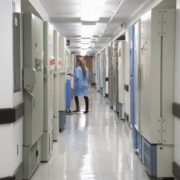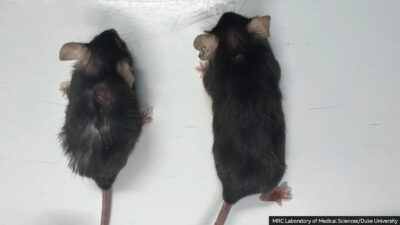Researchers in Boston believe they have finally discovered what causes aging in the human body. Scientists adjusted the DNA in lab mice in ways that either reversed or accelerated the aging process. Older mice regained their eyesight, grew healthier muscle and kidney tissue, and even developed smarter, younger brains, while younger mice aged prematurely, growing gray fur and watching their bodies decline.
David Sinclair, lead author of the study recently published in Cell and professor of genetics in the Blavatnik Institute at Harvard Medical School and co-director of the Paul F. Glenn Center for Biology of Aging Research, said the results show that aging is a reversible process, capable of being driven “forwards and backwards at will.”
Sinclair has been searching for the source of aging in mammals for years. Scientists have long focused on the process of senescence in cells and what causes it. Previously, researchers believed that mutations in a person’s DNA disrupted the cell’s normal operations and eventually lead to cell death. But the theory turned out to be false. Older people don’t usually have cells riddled with mutations and animals with large numbers of mutated cells don’t seem to age prematurely.
So, Sinclair and his team turned their focus to the epigenome, the part of the genome that tells other cells how to function and what type of cell to become. The epigenome programs each cell by adjusting the instructions in the DNA, deciding which genes to turn on and off. This is how skin cells become skin cells and brain cells become brain cells, a process called differentiation. They discovered that the aging process is caused by disruptions in the epigenome. Sinclair compared it to a piece of corrupt software on a hard drive. Sometimes the machine needs to be rebooted.
This new theory challenges the idea that aging is caused by genetic mutations in our DNA, as if we become a junkyard of damaged, diseased cells when we get older.
“If the cause of aging was because a cell became full of mutations, then age reversal would not be possible,” Sinclair said. “But by showing that we can reverse the aging process, that shows that the system is intact, that there is a backup copy, and the software needs to be rebooted.”
“It’s not junk,” he added. “It’s not damage that causes us to get old. We believe it’s a loss of information — a loss in the cell’s ability to read its original DNA so it forgets how to function — in much the same way an old computer may develop corrupted software. I call it the information theory of aging.”
For the study, scientists developed a way to reboot cells to restart the epigenome instructions, which effectively erased all the corrupted signals that accelerated the aging process. The younger mice who were “aged” went on to show signs of decline within a matter of weeks. They grew gray fur, lost weight despite maintaining the same diet, became more lethargic, and showed signs of increased frailty.
They created a gene therapy using the three genes that instruct the cells to reprogram themselves. They are a part of the Yamanaka stem cells factors, four genes that can revert adult cells to an embryonic, stem cell state so they can start their development, or differentiation process, all over again.
But Sinclair didn’t want to completely erase the instructions, as this is what gives the organism its identity. Rather, he wanted to erase them just enough to reset the epigenome instructions.
“We’re not making stem cells but turning back the clock so they can regain their identity,” Sinclair explained. “I’ve been really surprised by how universally it works. We haven’t found a cell type yet that we can’t age forward and backward.”
He is gearing up to find out whether the same technique can be used to reverse aging in humans. He is already testing the system in non-human primates. The research involves attaching a biological switch that allows the scientists to turn the aging clock on and off by tying the reprogramming of the epigenome to an antibiotic known as doxycycline. Giving the animal the antibiotic would reverse the aging process and stopping the drug would accelerate it.
“We think of the processes behind aging, and diseases related to aging, as irreversible,” says Sinclair. “In the case of the eye, there is the misconception that you need to regrow new nerves. But in some cases, the existing cells are just not functioning, so if you reboot them, they are fine. It’s a new way to think about medicine.”
Sinclair and his team believe this information could be used to prevent a host of diseases brought on by aging, including Alzheimer’s, heart disease and others.
But first they are looking to redefine what it means to age. “We don’t understand how rejuvenation really works, but we know it works,” he said. “We can use it to rejuvenate parts of the body and hopefully make medicines that will be revolutionary. Now, when I see an older person, I don’t look at them as old, I just look at them as someone whose system needs to be rebooted. It’s no longer a question of if rejuvenation is possible, but a question of when.”
















